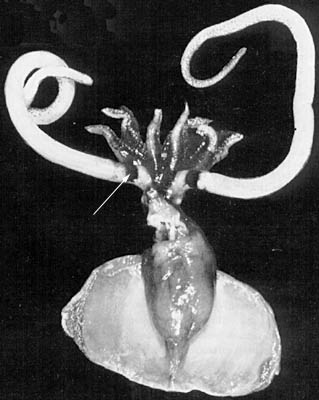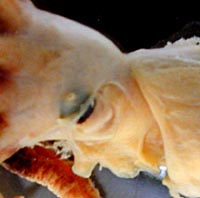Promachoteuthidae
Promachoteuthis
Richard E. Young and Michael Vecchione- Promachoteuthis megaptera Hoyle, 1885
- Promachoteuthis sloani Young, Vecchione & Piatkowski 2006
- Promachoteuthis sp. B
- Promachoteuthis sulcus Young, Vecchione and Roper, 2007
- Promachoteuthis sp. D
Introduction
The members of the Promachoteuthidae are mostly small, weakly muscled squids that seem to occur exclusively in the great depths of the bathypelagic zone of the world's oceans. Species of Promachoteuthis are known from only 12 specimens (two have not been described in the literature - Voss, 1992) among five, mostly geographically restricted, species. Although the data are few, the apparent high diversity and restricted distributions are unexpected for cephalopods inhabiting the bathypelagic region of the world's oceans. Maximum size recorded is a 184 mm ML mature male (Voss, 1992) but this specimen has not been described. A distinctive feature is the reduction in the size of the eyes which is exteme in Promachoteuthis sp. B. This species has the smallest eyes (relative to the squid size) of all squids and their eyes are buried in gelatinous tissues of the head but retain contact with sea water via slender canals. Little is known of the biology of these rare squids.
Diagnosis
A member of the chiroteuthid families ...
- with pseudocorneas covering small eyes.
- without ink sac and anal flaps.
Characteristics
- Arms
- Arms with suckers in two to three series; may have more near arm tips; varies among species.
- Arms with suckers in two to three series; may have more near arm tips; varies among species.
- Tentacles
- Stalks thick; usually much wider than arm III width (tentacle width less than arm width in P. sp. D).
- Club with suckers in numerous irregular series.
- Head
- Head often fused to mantle in nuchal region.
- Eyes small to very small.
- Eyes with reduced eye openings; each eye with a translucent "pseudocornea" over the eye lens.
Figure. Side view of head and anterior mantle of P. sulcus, holotype, preserved. Note the head-mantle fusion, small eye, pseudocornea and small eye opening (looks like a small nipple in the photograph). Skin is torn just posterior to the pseudocornea. Photograph by R. Young.
- Funnel
- Funnel locking apparatus with oval depression.
- Funnel locking apparatus with oval depression.
- Fins
- Fins large, usually with posterior lobes (posterior lobes may be absent in P. megaptera).
- Fins large, usually with posterior lobes (posterior lobes may be absent in P. megaptera).
- Viscera
- Anal flaps absent.
- Ink sac absent.
- Photophores
- Absent.
- Absent.
- Gladius
- Reduced and variable among species.
Comments
The variable appearance of the gladius among species is presumably due to the reduction in size (usually it is well less than the mantle length) and function. Most species can quickly be recognized as a member of this family by the very thick tentacles and small eyes.
Nomenclature
A list of all nominal genera and species in the Promachoteuthidae can be found here. The list includes the current status and type species of all genera, and the current status, type repository and type locality of all species and all pertinent references.
References
Okutani, T. 1983. Rare and interesting squid from Japan. VIII. Rediscovery of Promachoteuthis megaptera Hoyle, 1885 (Oegopsida: Promachoteuthidae). Venus 42: 241-247.
Roper, C. F. E. and R. E. Young. 1968. The family Promachoteuthidae (Cephalopoda: Oegopsida). I. A re-evaluation of its systematic position based on new material from Antarctic and adjacent waters. Ant. Res. Ser. 11: 203-214.
Salcedo-Vargas, M. A. and J. Guerrero-Kommritz. 2000. Three new cephalopods from the Atlantic Ocean. Mitt. Hamb. Zool. Mus. Inst., 97: 31-44.
Toll, R. B. 1998. The gladius in teuthoid systematics. Smithson. Contr. Zool., No. 586: 55-68.
Voss N. A. 1992. Family Promachoteuthidae. Smithson. Contr. Zool., 513: 183-185.
Title Illustrations

| Scientific Name | Promachoteuthis megaptera |
|---|---|
| Comments | Arrow points to the unusual pigment band at the base of the tentacle. |
| Reference | Okutani, T. 1983. Rare and interesting squid from Japan. VIII. Rediscovery of Promachoteuthis megaptera Hoyle, 1885 (Oegopsida: Promachoteuthidae). Venus 42:241-247. with permission. |
| Sex | Female |
| Life Cycle Stage | Immature |
| Size | 52 mm ML |
About This Page

University of Hawaii, Honolulu, HI, USA

National Museum of Natural History, Washington, D. C. , USA
Page copyright © 2019 and
 Page: Tree of Life
Promachoteuthidae . Promachoteuthis .
Authored by
Richard E. Young and Michael Vecchione.
The TEXT of this page is licensed under the
Creative Commons Attribution-NonCommercial License - Version 3.0. Note that images and other media
featured on this page are each governed by their own license, and they may or may not be available
for reuse. Click on an image or a media link to access the media data window, which provides the
relevant licensing information. For the general terms and conditions of ToL material reuse and
redistribution, please see the Tree of Life Copyright
Policies.
Page: Tree of Life
Promachoteuthidae . Promachoteuthis .
Authored by
Richard E. Young and Michael Vecchione.
The TEXT of this page is licensed under the
Creative Commons Attribution-NonCommercial License - Version 3.0. Note that images and other media
featured on this page are each governed by their own license, and they may or may not be available
for reuse. Click on an image or a media link to access the media data window, which provides the
relevant licensing information. For the general terms and conditions of ToL material reuse and
redistribution, please see the Tree of Life Copyright
Policies.
- Content changed 27 February 2016
Citing this page:
Young, Richard E. and Michael Vecchione. 2016. Promachoteuthidae . Promachoteuthis . Version 27 February 2016 (under construction). http://tolweb.org/Promachoteuthis/19454/2016.02.27 in The Tree of Life Web Project, http://tolweb.org/









 Go to quick links
Go to quick search
Go to navigation for this section of the ToL site
Go to detailed links for the ToL site
Go to quick links
Go to quick search
Go to navigation for this section of the ToL site
Go to detailed links for the ToL site